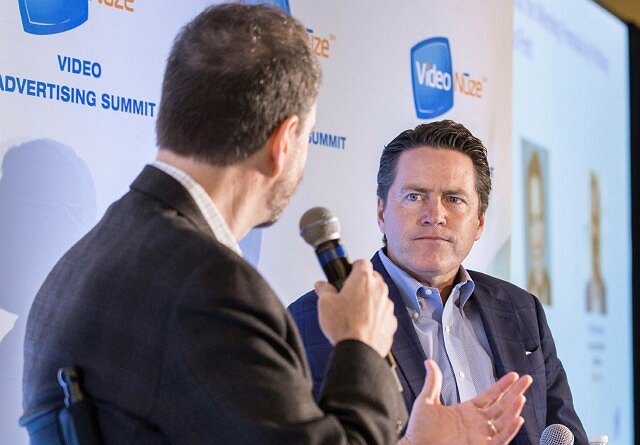 Navigating the transition from collecting and mining data to actually applying it in addressable advertising is a talent that a4
President Paul Haddad (pictured at top) has in abundance. With an
engineering background and extensive work in collecting data at the
set-top box level from his tenure at Cablevision, he has a keen sense of
how the addressable landscape looks and what the underpinnings of data
and analytics need to be to ensure a seamless, real-time, targeted
experience for both consumers and advertisers.
Navigating the transition from collecting and mining data to actually applying it in addressable advertising is a talent that a4
President Paul Haddad (pictured at top) has in abundance. With an
engineering background and extensive work in collecting data at the
set-top box level from his tenure at Cablevision, he has a keen sense of
how the addressable landscape looks and what the underpinnings of data
and analytics need to be to ensure a seamless, real-time, targeted
experience for both consumers and advertisers.A One-Stop Advertising Shop
Utilizing data culled from many sources and offers, a4 is "a one-stop shop for audience-driven, integrated, multi-screen advertising and end-to-end ROI analytics across the U.S.," Haddad said. But as complete as that sounds, that is not all it is. Owned by Altice, which purchased Cablevision in 2015, a4 is actually a large advertiser in its own right, representing Altice's $200 million budget as an in-house agency. So, a4 not only offers capability in both the buying and selling aspects of advertising, it also manages and stewards small $250 campaigns to multi-million-dollar campaigns, as well as national and local accounts through an interface platform controlled by the advertiser. a4 is helping to transition the media world by "inventing the way advertising works," and it has been very successful. "We now have over $500 million in total media revenue, over 500 employees and the fastest growing business at Altice," Haddad noted.
Going from Local to National
Transitioning from local MVPD operation to a national footprint was not without some internal questions. "What is an audience to us?" Haddad posited. "Is it market-driven or is it location-driven or is it size-driven?" After two years of tests, he realized that "audience targeting has no location or specific size." So, the conclusion was that "when it comes to audience, we do not see the world as local or national at all," he explained. "We do not see the world as TV or digital. We see the world as household targets. We deliver a household-based audience targeted campaign across all screens anywhere in the U.S. at any time and at any size of segment." In sum, a4 essentially removes the need to label anything other than audience at a household level -- and that appears to be the wave of the future.
Haddad said that those still operating under the legacy mindset of local versus national are "limiting" themselves and warned that his competitors who stick to the old parameters of measurement are "being held as techno-hostages."
Finding Intent in Targeting
a4 has access to a myriad of datasets at the MVPD set-top box level, at the device level, at various digital touch points and through third and first-party partnerships. To ensure privacy and create effective reach pathways, "our datasets are focused on household targeting," he explained. "To target a household, you need to understand and provide to our advertising clients the means to create a segment. And the way to create the segment is to collect data that finds intent."
He noted that intent on a household level is based on:
- Viewing and content consumption (a4 currently covers 12.5 million homes at the set-top box level covering 210 DMAs)
- Spending patterns (such as luxury items or beauty products or tech-gadgets)
- Consumer profile data (totaling 300 million homes)
- Geo-location data (sports stadium visits or high-end store or auto dealership visits)
- IP targeted data with a platform deployed behind the firewall at most MVPDs in the U.S. (accessing 50 million household data on digital and mobile devices for in and out-of-home addressability.)
In addition, a4 gives the client an on-boarding, self-service, full stewardship platform where proprietary CRM data can be uploaded privately and safely and matched with all of a4's data free of charge and within hours, not days. So, from audience creation to media planning to media activation across all screens (which includes linear and optimized TV, OTT, digital video and display, social media, mobile display and in-apps banner), "we provide the measurement at the household level, plus all of these screens for the campaign, from the exposure to the medium to how often, and then we post at the end of the campaign."
As far as privacy is concerned, Altice applies a strict and disciplined compliance approach to all its data operations and business use cases. "Privacy is extremely important and serious to us," Haddad asserted.
Time for a "Datalution"
Giving the client full access and control over all aspects of a campaign by targeting the intent of households is something that few companies offer. Haddad shepherds his company in a new direction that is poised to change the business of advertising as we know it. "The advertising world is broken into a fast lane of born-data companies and the slow lane of legacy processes," he said. "The slow lane has no choice but to revolutionize the way they do business. It's a question of time."
The clock is ticking.
This article first appeared in www.MediaVillage.com

 Hulu
continues to keep up with the times. When it first launched 11 years ago it was
100% desktop delivered. Now, according to Peter Naylor,
Hulu
continues to keep up with the times. When it first launched 11 years ago it was
100% desktop delivered. Now, according to Peter Naylor,